It improved significantly also (at 2 % addition level) fish carcass protein percent. The obtained results for CSM revealed improving effect of this feed additive (particularly at 1 %) on fish growth rates (relative and specific) and feed utilization (feed protein intake, protein productive value, protein efficiency ratio, energy retention). Also, fish carcass ether extract and energy content had increased by this treatment. So, it could recommend the dietary addition of 1-2 % FSM or CSM to Nile tilapia, but it may need more research on the effect of such feed additive on the organoleptic test of the fish meat.
Introduction
Based on the existing efforts to promote sustainable aquaculture, environmental-friendly processed feeds should be addressed, developed and implemented (Frankic and Hershner, 2003). Because of the rapidly increasing of worldwide aquaculture, aqua feed's supply is less than its demand; so, many efforts are undertaken to overcome this gap. Among these efforts is evaluation of novel feed sources, such recycling some valuable agro-industrial by-products (El-Komy, 2006), field crops' wastes (Srour et al., 2002), aquatic flora (Elmorshedy, 2010), restaurants and markets' trash (Eissa et al., 1985), and spices and medical plants (Abd El-Hakim, 2008) whether to substitute one of the conventional feed stuffs in a diet or for their attractive or immunostimulatory effects.
Trigonella foenum-graecum (Fenugreek) seeds are belonging to legume and are planted in the newly reclaimed lands. Adjunct use of fenugreek seeds improves glycemic control and decreases insulin resistance in mild type-2 diabetic patients. They have also a favorable effect on hypertriglyceridemia (Gupta et al., 2001).
Cresson (Lepidium sativum) seeds are recommended for the good health and reproduction. Lepidium sativum seeds showed the presence of allyl, 2-phenethyl and benzyl glucosinolates. Five new possible benzyl glucosinolate degradation products were detected and evidence is presented that benzaldehyde and benzyl alcohol could be secondary products formed thermally from isothocyanate and thiocyanate, respectively. Benzyl mercaptan and benzyl methyl sulphide also appear to be thermally produced (Gil and MacLeod, 1980). Lepidium sativum (Garden Cress, Family: Cruciferae) showed statistically significant improvement in various parameters of pulmonary functions in asthmatic subjects. Also significant improvement was observed in clinical symptoms and severity of asthmatic attacks (Paranjape and Mehta, 2006). The present research aimed to evaluate the effect of graded dietary levels (0, 1, and 2%) of Fenugreek or Cresson meals on tilapia fish performance.
Materials and Methods
An indoor feeding experiment was conducted to evaluate dried fenugreek (Trigonella fonaeum-gracum) seed meal as a dietary additive concerning its effect on growth performance, carcass composition and feed utilization of Nile tilapia, Oreochromios niloticus, fry for 16 weeks. The experimental system consisted of 15 plastic tanks; each tank was continuously supplied with a compressed air from an electric compressor (Shenzehe Company BS410). Dechlorinated tap water was used to change one third of the water in each tank every day. Water was aerated before be used for about 24 hours to remove chlorine.
Experimental Fish: A group of Nile tilapia, O. niloticus, fry with an average initial body weight of (0.28 – 0.30 g) were obtained from a private farm at AL Hamoul, Kafr El-Sheikh governorate, Egypt and transported to the wet lab., then maintained in the tanks for 2 weeks before the beginning of the experiment for acclimatization purpose. The fish were fed during the acclimatization period on the basal diet (30% crude protein) at a rate of 20 % of the body weight 2 times daily. The experimental treatments were tested at three tanks (replicates) for each. Fish were stoked at a density of 7 fish / tank (each of 16 liter water).
Experimental Diet: Dried fenugreek (Trigonella fonaeum gracum) seed meal was added to diets at levels of 0, 1 and 2%. All feedstuffs used in the experimental diets were purchased from the local market. The basal diet No.1 was considered as a control. Composition and chemical analysis of the basal and experimental diets are presented in Tables 1 which obviously showed that all diets were iso-caloric and iso-nitrogenous. The composition of the vitamins and minerals mixture is presented in Table 2.
Experimental Procedure: The experiment continued for 16 weeks. During the experimental period, the fish were fed the experimental diets at a rate of 20 % of the live body weight daily. The diet was introduced twice daily, at8 a.m. and 2 p.m. The amount of feed was adjusted weekly based on the actual body weight changes. Samples of water were taken daily before changing the water and after adding the diets weekly from each aquarium to determine water quality parameters. Light was controlled by a timer to provide a 14 h light: 10 h dark as a daily photoperiod.
Analytical Methods: Samples of water from each aquarium were taken to determine the water temperature, pH value, and dissolved oxygen, concentrations according to Abdelhamid (1996). Water temperature in degree centigrade was recorded every day by using a thermometer. The pH value of water was measured daily using an electric digital pH meter (using Jenway Ltd, model 350-pH meter). Dissolved oxygen concentration was determined weekly using an oxygen meter model (d-5509). Determination of DM, CP, EE, CF, and ash in the diets and in fish body at the start and at the end of the experiment for different groups were carried out according to the method of A.OA.C. (1990). At the end of the experiment, three fish were derived from each group (aquarium) for drying at 60ºC for 48 hours and then milled through electrical mill and kept at 4oC until analysis.
Growth Performance and Feed Utilization: The growth performance and feed utilization parameters were calculated according to the following equations:
Average weight gain (AWG, g/fish) = Average final weight (g)-Average initial weight (g).
Average daily gain (ADG, mg/fish) = ?Average final weight (g)-Average initial weight (g) ? 1000 / Time (days).
Survival rate (SR %) = Total number of fish at the end of the experiment × 100 / total number of fish at the start of the experiment.
Relative growth rate (RGR) = Average weight gain (g) / Average initial weight (g).
Specific growth rate (SGR, % / day) = 100 [ln wt1- ln wto/T].
Where: ln: Natural log. Wto: Initial weight (g), Wt1: Final weight (g), and T: Time in days.
Feed conversion ratio (FCR) = Total feed consumption (g)/ Weight gain (g).
Protein efficiency ratio (PER) = Body weight gain (g)/protein intake (g).
Protein productive value (PPV %) = 100 [Retained protein (g)/protein intake (g)].
Energy retention (ER %) = 100 [Retained energy (Kcal) / Energy intake (Kcal)].
Water quality: Water quality parameters measured (temperature, pH and dissolved oxygen) did not differ among treatments. Values of the measured criteria were within the suitable ranges for rearingNile tilapia fish.
Statistical Analysis: The data were statistically analyzed by using general linear models procedure adapted by SAS (1996) for users guide. Means were separated using Duncan's multiple range test (Duncan, 1955).
Table 1: Composition (%) and Chemical Analysis (% Dry Matter Basis) of the Experimental Diets.
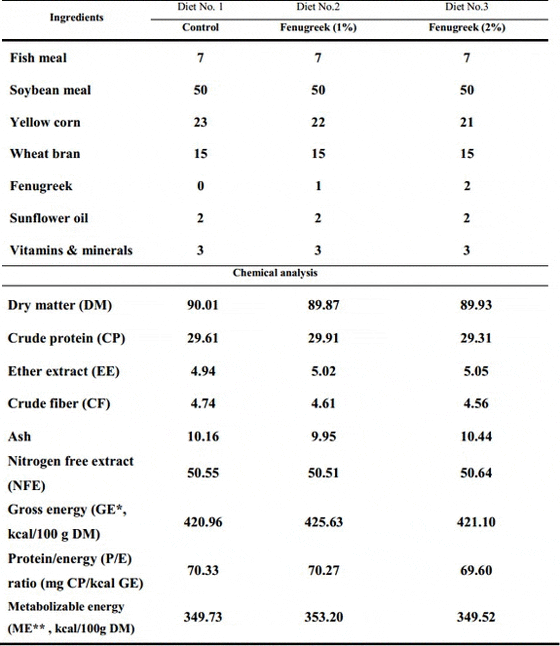
**ME (kcal/100g DM= Metabolically energy ws calculated using factors 3.49, 8.1 and 4.5 kcal/g for carbohydrates fat and protein, respectively according to Pantha (1982)
Table 2: Composition of the Vitamins and Minerals Mixture*calculated for each kg of the Mixture) in the Diets.
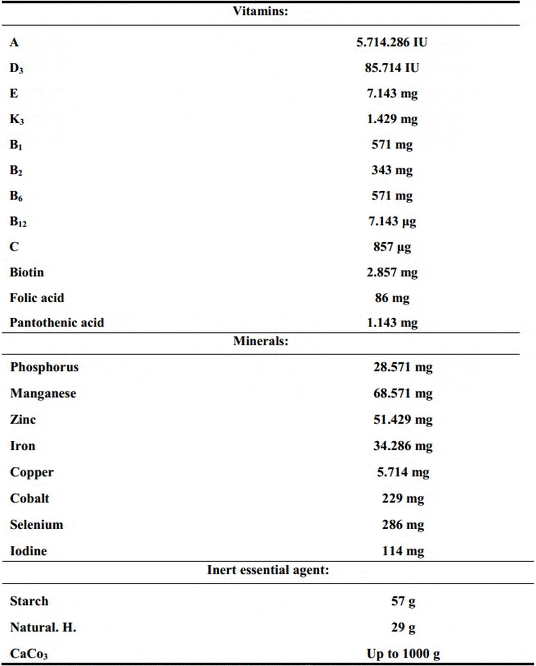
Water Quality
Table 3 presents the means of some tested quality parameters of the fish rearing water, being 24 - 26 °C, 7.5 – 8.5, and 5 – 6 mg/l for water temperature, pH value and dissolved oxygen (DO), respectively meaning that the water quality was suitable for Nile tilapia fry rearing according to Abdelhamid (2009). Water quality parameters measured did not differ among treatments.
Table 3: Ranges of some Water Parameters Measured in the Experimental Tanks
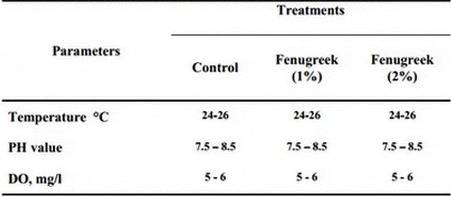
Growth Performance
There were no significant (P?0.05) differences among treatments in initial (IW) and final (FW) fish weights nor in average weight gain (AWG) and average daily gain (ADG) as shown from Table 4. Also, Table 5 showed no significant (P?0.05) differences among treatments in the relative growth rate (RGR), specific growth rate (SGR), or survival rate of the experimental fish groups due to the dietary inclusion of fenugreek. But the dietary inclusion of Cresson (particularly at 1 % level) improved each of final weight (FW), average weight gain (AWG), and average daily gain (ADG) but not significantly (P?0.05) as presented in Table 4. Yet, 1 % Cresson including diet significantly (P?0.05) increased relative growth rate (RGR) and specific growth rate (SGR) as given in Table 5 comparing with the control (free of Cresson). Meanwhile, there were no significant (P?0.05) differences among treatments in the survival rate (SR). Similar results were obtained by Abd Elmonem et al. (2002) who reported significant improvements in growth performance and feed utilization in red tilapia fed diets containing 6% black seed meal or 3% roquette seed meal comparing with control. Abd El-Hakim (2008) fed brood stock tilapia fish on licorice or ginger included diets that improved fry performance. Since 1 % addition level led to better final weight, gain, SGR, survival and feed conversion. Moreover, Attalla (2009a) mentioned also that feeding with a mixture of ginger (powder and oil extract) can promote all growth parameters and decrease mortality rate of Nile tilapia. These positive effects of most feed additives may be due to their active pharmacological (medical) substances.
Table 4: Data of some Growth Performance Parameters of the Experimental Fish.
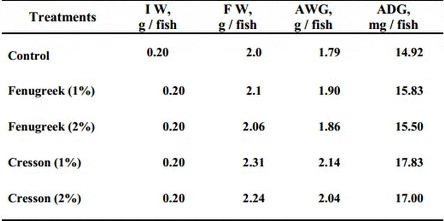
Table 5: Means of Relative Growth Rate (RGR), Specific Growth Rate (SGR) and Survival Rate (SR) of the Experimental Fish.
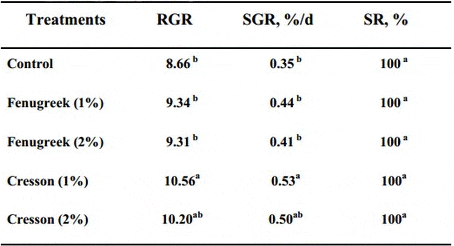
Feed Utilization
Table 6 reflects significant (P?0.05) differences among treatments only in the values of protein productive value (PPV %) protein efficiency ratio (PER) and energy utilization (EU %), since the fenugreek and Cresson containing diets were superior to the control. The diet containing 2 % fenugreek was the best in PPV % while that containing 1 % fenugreek was the best in EU %.
However, Dietary inclusion of medicinal plants (garlic, El-Saidy and Gaber, 1997; onion and garlic, Zaki and El-Ebiary, 2003; Allium sativum and Thymus vulgaris, Attalla, 2009b) often increases fish performance, nutrients utilization and chemical composition. Since Abd Elmonem et al. (2002) reported significant improvements in growth performance and feed utilization in red tilapia when fed diets containing 6% black seed meal or 3% roquette seed meal comparing with control. Also, El-Dakar (2004) and El-Dakar et al. (2004) found that 0.5% of either caraway or fennel seeds' meals respectively gave the best palatability index, growth performance, feed and nutrients utilization, and profit index for tilapia fish comparing with the other addition levels and the control. Similar results were obtained when Abd El-Hakim (2008) fed brood stock tilapia fish on licorice or ginger included diets, that improved survival rate and led to better feed utilization (to produce 1000 fry).
Table 6: Means* of Feed Utilization Parameters of the Experimental Fish.
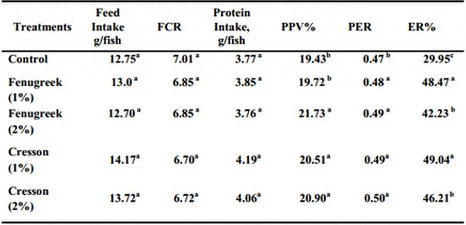
Carcass Composition
Tables 7 and 8 illustrate the chemical composition of the fish at the start and at the end of the experiment, respectively. The percentages of dry matter (DM) and crude protein (CP) had increased by aging (after 112 days experimental period) but the ether extract and ash percentages had decreased. The significant (P?0.05) differences were calculated only among treatments for CP, EE, and energy content (EC) at the end of the experiment (Table 8). The lowest EE and EC were in the control fish group but the highest CP was found in the fish group fed the diet containing 2 % fenugreek. However, the dietary inclusion of Cresson leaves meal significantly (P?0.05) increased each of EE and energy content (EC) but decreased the DM content of the fish body (Table 8) comparing with the control. Table 8 presents also a negative relationship between CP and EE.
However, Dietary inclusion of medicinal plants (garlic, El-Saidy and Gaber, 1997; onion and garlic, Zaki and El-Ebiary, 2003; Allium sativum and Thymus vulgaris, Attalla, 2009b) often improves chemical composition of the fish. Table 8 presents also a negative relationship between CP on one side and EE and EC on the other side, but a positive relationship between both EE and EC. A negative relationship between crude proteins and crude fats in the chemical composition of Nile tilapia fish was reported before (El-Ebiary and Zaki, 2003 and Abdelhamid et al., 2007).
Table 7: Chemical Composition (% Dry Matter Basis) of the Experimenal Fish at the Start.
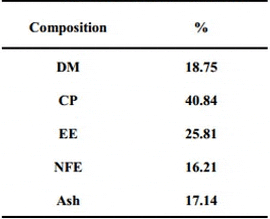
Table 8: Means*of Chemical Composition (% Dry Matter Bases) of Nile Tilapia Carcass as affected by the Dietary Treatments.
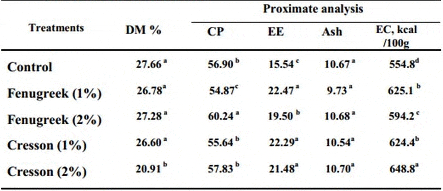
These positive effects of the used feed additives are due to their active pharmacological (medical) substances. Since the therapeutic role of Trigonella seed powder in type1 diabetes can be attributed to the change of glucose and lipid metabolizing enzyme activities to normal values, thus stabilizing glucose homeostasis in the liver and kidney (Raju et al., 2001). Trigonellafoenum-graecum L. has also an immunomodulatory activity, so it is widely used as a medicinal and dietary herb (Bin-Hafeez et al., 2003). The antineoplastic effect of Trigonella foenum-graecum seed extract has been evaluated. The extract also produced a significant anti-inflammatory effect (Suret al., 2001). Fenugreek seeds possess antiulcer potential (Pandian et al., 2002). Also, Garden cress (Lepidium sativum) is belonging to the family Cruciferae. The edible whole seed is known to have health promoting properties. Hence, it was assumed that these seeds can be a functional food or nutraceutical food. The whole meal had 22.5 % protein, 27.5 % fat, 30 % dietary fiber (DF), and 1193 mg % potassium. The most abundant amino acid was glutamic acid (19.3 %) and the essential amino acid; leucine was the highest (8.21 %) and methionine the lowest (0.97 %). The major fatty acid was linolenic acid (30.2%) and low amount of erucic acid (3.9%) was also present (Gokavi et al., 2004).
Conclusively and from the obtained results of the present study, it could recommend the dietary addition of 1-2 % fenugreek seed meal or Cresson seeds meal to Nile tilapia fry (0.28 g) to improve its performance.
July 2013




